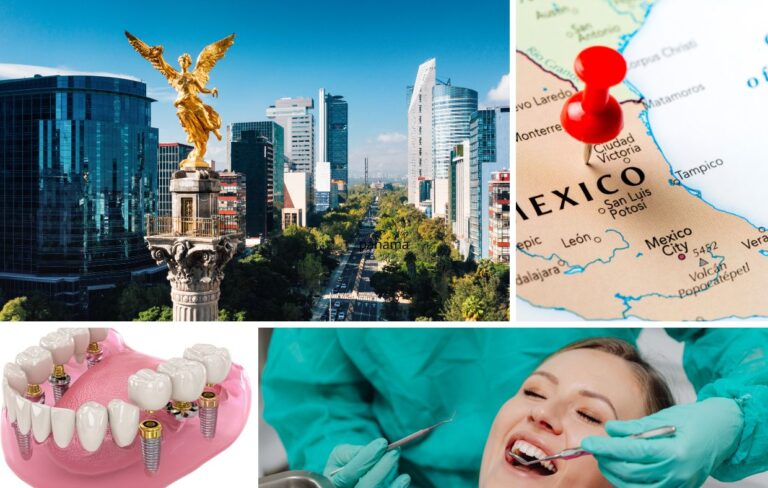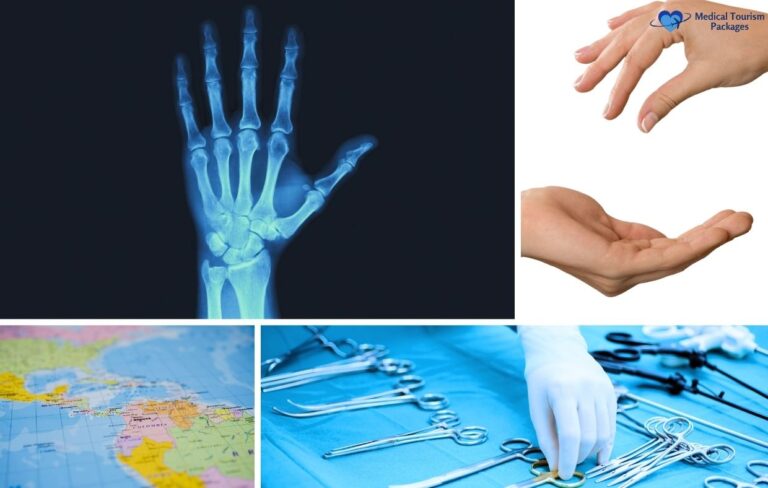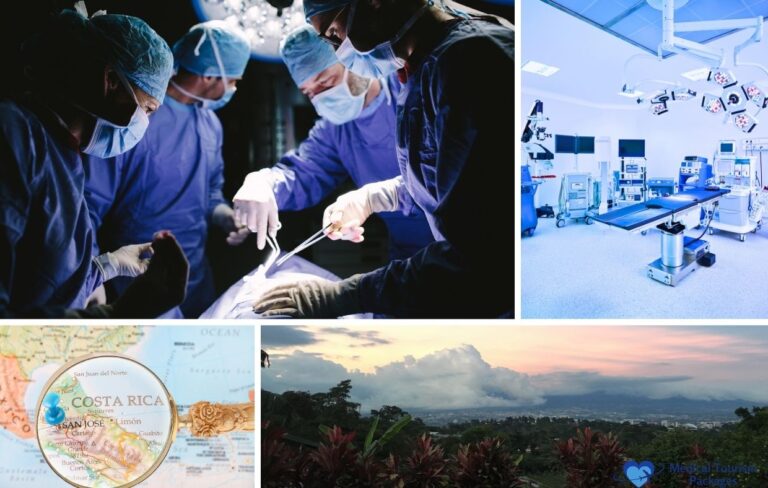Book Appointment Now
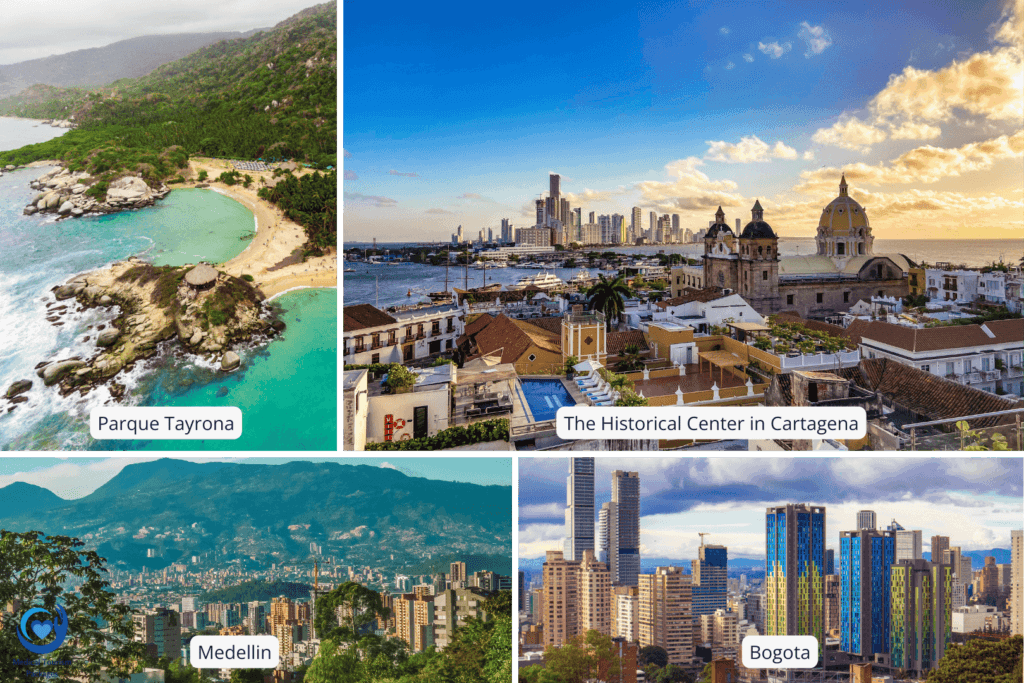
Medical Tourism in Latin America: A Guide for American Medical Tourists
Medical tourism allows patients to travel abroad for healthcare. Americans choose this option for three main reasons: lower costs, shorter wait times, and access to specialized care. Procedures range from elective treatments like cosmetic surgery and dental work to major operations including heart bypasses and joint replacements. Latin America encompasses Mexico, Central America, South America, and parts of the Caribbean. The region’s healthcare systems blend Indigenous, African, European, and Asian medical traditions. This diversity creates unique treatment approaches. Modern facilities now combine traditional healing practices with cutting-edge medical technology. The result is comprehensive care that often exceeds American standards at a fraction of the cost.
Why Do American Medical Tourists Choose Latin America for Healthcare?
American medical tourists increasingly choose Latin America for three compelling reasons that make it an attractive alternative to domestic healthcare.
How Much Can Americans Save on Medical Procedures in Latin America?
Cost savings represent the primary draw for American patients. Most procedures cost 40-80% less than in the United States. Mexico attracts 1.2 million Americans annually with savings of 50-80% on most treatments. The country dominates dental tourism with accessible border locations. Costa Rica delivers 40-60% savings across various procedures while maintaining high quality standards. Panama offers procedures at 50-70% below U.S. prices with the added benefit of using the American dollar. Colombia provides 50-70% savings, particularly for cosmetic procedures. These savings include the procedure itself, hospital stays, and post-operative care. Even after factoring in travel expenses, patients save thousands of dollars. A $30,000 surgery in America might cost $8,000 in Latin America with comparable quality.
What Makes Latin America Geographically Convenient for American Patients?
Latin America’s proximity to the United States offers several travel advantages for medical tourists:
- Mexico: Border cities sit minutes from U.S. entry points. San Diego to Tijuana takes under 30 minutes. No flight required for border procedures.
- Costa Rica: Multiple daily flights depart from major U.S. cities. Flight times average 3-5 hours from most locations.
- Panama: Strategic location enables shorter travel times. Direct flights connect Panama City with Miami, Houston, and New York daily.
- Colombia: Direct flights operate from major metropolitan areas. Bogotá and Medellín connect easily with U.S. hub cities.
How Does the Quality of Healthcare in Latin America Compare to the United States?
Quality concerns often worry first-time medical tourists. The reality challenges these fears. Mexico maintains 9-10 JCI-accredited hospitals with U.S.-trained surgeons. Costa Rica operates state-of-the-art facilities where doctors train internationally. Panama’s Hospital Punta Pacifica holds JCI accreditation and partners with Johns Hopkins Medicine. Colombia hosts internationally accredited hospitals specializing in complex procedures. Many Latin American surgeons complete residencies at prestigious American institutions. They return home bringing advanced techniques and protocols. Equipment in top facilities matches or exceeds what American hospitals use. The difference lies in operational costs, not quality standards.
Which Latin American Countries Are Best for American Medical Tourists?
Four countries have emerged as primary destinations for American medical tourists, each offering unique advantages in terms of specializations, accessibility, and healthcare infrastructure tailored to international patients.
What Makes Mexico the Leading Destination for American Medical Tourists?
Mexico receives an estimated 1.2 million American medical tourists annually. The country captures 63% of all U.S. medical visits for dental tourism. Border cities offer medical fast-pass lanes for patients. Proximity eliminates flight costs for many procedures. For comprehensive details about Mexican facilities, top procedures, and cost breakdowns, see our Mexico Medical Tourism Guide.
Why is Costa Rica Popular Among American Medical Tourists?
Costa Rica leads Latin America for dental work combined with eco-friendly recovery. The country developed strong medical tourism infrastructure over decades. Facilities cater specifically to international patients. Natural beauty aids recovery with stress-reducing environments. For complete information about Costa Rican hospitals, popular procedures, and planning resources, see our Costa Rica Medical Tourism Guide.
How Has Panama Emerged as a Medical Tourism Hub for Americans?
Panama uses the U.S. dollar, eliminating currency exchange concerns. The country receives approximately 50,000 medical tourists annually. Modern facilities cluster in Panama City for easy access. Strong ties to American healthcare systems ensure familiar protocols. For detailed information about Panamanian medical facilities, procedures, and travel logistics, see our Panama Medical Tourism Guide.
What Makes Colombia an Emerging Destination for American Medical Tourists?
Colombia earned recognition as South America’s cosmetic surgery capital. The country offers ideal year-round recovery climate. Cities like Medellín and Bogotá combine medical excellence with cultural experiences. Surgeons specialize in aesthetic procedures with artistic precision. For comprehensive details about Colombian surgeons, facilities, and procedure options, see our Colombia Medical Tourism Guide.
What Medical Procedures Do Americans Commonly Seek in Latin America?
From cosmetic enhancements to life-changing surgeries, Latin America offers a comprehensive range of medical procedures at significantly reduced costs, with certain specialties becoming synonymous with specific countries.
Which Cosmetic Surgery Procedures Are Most Popular?
The most popular procedures among medical tourists visiting Latin America are: breast augmentation, face lift, rhinoplasty, liposuction and abdominoplasty (or tummy tuck).
| Procedure | Mexico Range | Costa Rica Range | Panama Range | Colombia Range | U.S. Average |
|---|---|---|---|---|---|
| Breast Augmentation | $3,500-$4,500 | $4,000-$5,500 | $4,500-$6,000 | $3,000-$4,500 | $6,000-$12,000 |
| Facelift | $3,000-$5,000 | $4,500-$6,500 | $5,000-$7,000 | $3,500-$5,500 | $7,000-$15,000 |
| Rhinoplasty | $2,500-$4,000 | $3,500-$5,000 | $4,000-$5,500 | $2,800-$4,200 | $5,000-$10,000 |
| Liposuction | $2,000-$3,500 | $2,500-$4,000 | $3,000-$4,500 | $2,200-$3,800 | $3,500-$8,000 |
| Tummy Tuck | $3,500-$5,000 | $4,000-$6,000 | $4,500-$6,500 | $3,200-$5,200 | $6,000-$12,000 |
For detailed pricing and surgeon information, see individual country guides
What Dental Treatments Do Americans Get in Latin America?
Dental implants and crowns are among the most popular procedures for medical tourists in Latin America. More comprehensive procedures such as full-mouth restorations are also popular due to the cost differential when compared to the USA.
| Procedure | Mexico | Costa Rica | Panama | Colombia | U.S. Average | Savings % |
|---|---|---|---|---|---|---|
| Dental Implants | $750-$1,200 | $800-$1,400 | $900-$1,500 | $800-$1,300 | $3,000-$4,500 | 60-75% |
| Crowns | $250-$450 | $300-$500 | $350-$550 | $280-$480 | $800-$1,500 | 65-70% |
| Veneers | $300-$500 | $350-$550 | $400-$600 | $320-$520 | $900-$2,500 | 60-75% |
| Full-Mouth Restoration | $6,000-$10,000 | $7,000-$12,000 | $8,000-$13,000 | $6,500-$11,000 | $30,000-$50,000 | 70-80% |
Which Bariatric Surgery Options Are Available?
All four countries offer gastric sleeve, gastric bypass, and other weight loss surgeries. Success rates reach 60-70% excess weight loss within the first year across all locations. Mexico specializes in border accessibility for follow-up care (Mexico Medical Tourism Guide). Costa Rica combines surgery with wellness retreats (Costa Rica Medical Tourism Guide). Panama provides comprehensive aftercare programs (Panama Medical Tourism Guide). Colombia offers competitive pricing with experienced surgeons (Colombia Medical Tourism Guide). Each country maintains strict protocols for patient selection and preparation. Pre-surgery evaluations ensure candidates meet health requirements. Post-operative support includes nutritional counseling and psychological services. For specific pricing, surgeon credentials, and facility recommendations, see the individual country guides linked above.
What Orthopedic Procedures Are Available to American Patients?
| Procedure | Mexico | Costa Rica | Panama | Colombia | U.S. Range |
|---|---|---|---|---|---|
| Knee Replacement | $10,000-$15,000 | $12,000-$17,000 | $13,000-$18,000 | $11,000-$16,000 | $35,000-$50,000 |
| Hip Replacement | $12,000-$17,000 | $13,000-$19,000 | $14,000-$20,000 | $12,500-$18,000 | $40,000-$60,000 |
How Do American Medical Tourists Choose the Right Hospital or Clinic in Latin America?
Selecting a healthcare provider abroad requires careful research and verification, with several key factors helping Americans identify facilities that meet international standards of safety and quality.
What International Accreditations Should Americans Look For?
Several international certifications indicate that a facility meets rigorous healthcare standards:
- Joint Commission International (JCI) – Gold standard for international hospitals. This accreditation requires facilities to meet the same standards as top U.S. hospitals.
- AAAASF – Accreditation for ambulatory surgery facilities. Essential for outpatient procedures and cosmetic surgery centers.
- COFEPRIS – Mexico’s FDA equivalent. Ensures facilities meet national safety and quality requirements.
- Country-specific certifications – Each nation’s health ministry establishes standards. Look for government approval documents.
How Can Americans Verify Doctor Credentials?
| Country | How to Verify | What to Look For |
|---|---|---|
| Mexico | Check CONAMED database, contact local medical boards | Board certification, U.S. training, active license status |
| Costa Rica | Verify through Colegio de Médicos y Cirujanos | Medical school graduation, specialty certification, clean record |
| Panama | Contact Consejo Técnico de Salud | Valid registration, specialty credentials, hospital privileges |
| Colombia | Check with Ministerio de Salud database | Professional license, specialty board certification, continuing education |
Where Can Americans Find Patient Reviews and Testimonials?
Reliable patient feedback can be found through multiple online and offline sources:
- RealSelf platform for cosmetic procedures with verified patient photos and detailed reviews
- Medical tourism forums and platforms including Medical Departures and Patients Beyond Borders
- Hospital and clinic websites featuring video testimonials and before-after galleries
- Social media pages of healthcare facilities with real-time patient updates
- Country-specific medical tourism associations that maintain quality standards
How Common Is English in Latin American Medical Facilities?
English proficiency varies significantly by country and facility. Mexico’s border facilities employ bilingual staff exclusively. San Miguel de Allende and other expat communities offer English-speaking doctors. Costa Rica’s medical tourism facilities maintain English-speaking coordinators and translators. Many doctors trained in the United States speak fluent English. Panama’s international hospitals staff bilingual personnel throughout departments. U.S. expatriate communities support English-speaking medical practices. Colombia’s major cities employ English coordinators for international patients. Bogotá and Medellín attract bilingual medical professionals. All four countries assign patient liaisons to American clients. These coordinators handle translation, appointment scheduling, and cultural navigation.
What Documents Do Americans Need for Medical Tourism in Latin America?
Proper documentation is essential for medical tourism, ensuring both legal entry and effective communication with healthcare providers across Latin America.
What Are the Passport and Visa Requirements?
| Country | Passport Validity | Visa Requirements for U.S. Citizens |
|---|---|---|
| Mexico | Valid for duration of stay | Not required for stays under 180 days |
| Costa Rica | Valid for duration of stay | Not required for stays under 90 days |
| Panama | Valid for 3 months beyond arrival | Not required for stays under 180 days |
| Colombia | Valid for 6 months beyond arrival | Not required for stays under 90 days |
Which Medical Records Should Americans Bring?
Comprehensive medical documentation ensures your Latin American healthcare team can provide appropriate care:
- Complete medical history including chronic conditions, allergies, and past surgeries
- Recent test results and imaging studies (X-rays, MRIs, CT scans) from the past six months
- Current medications list with dosages and frequency, including supplements
- Translation to Spanish recommended for all countries, though major facilities provide translation services
- Operative reports from previous surgeries, especially if the procedure relates to prior work
How Long Should Americans Stay in Latin America for Medical Procedures?
Recovery time varies significantly by procedure type, and understanding these timelines is crucial for planning your medical journey, booking accommodations, and arranging time away from work.
What Are Typical Recovery Times for Common Procedures?
| Procedure Type | Initial Stay | Travel Clearance | Total Recovery |
|---|---|---|---|
| Dental | 3-7 days | 1-3 days | 1-2 weeks |
| Cosmetic | 7-14 days | 7-10 days | 4-6 weeks |
| Bariatric | 5-7 days | 10-14 days | 6-8 weeks |
| Orthopedic | 7-10 days | 14-21 days | 3-6 months |
Where Do American Patients Stay During Recovery?
Each country offers specialized accommodation options designed for post-surgical recovery needs:
- Mexico: Specialized recovery houses with 24/7 nursing care, located near major medical facilities in Tijuana, Guadalajara, and Cancun
- Costa Rica: Recovery facilities in medical tourism zones offering spa-like environments with medical oversight and natural healing settings
- Panama: Patient-friendly hotels near medical facilities with wheelchair accessibility, medical equipment, and transportation services
- Colombia: Recovery centers with medical-grade equipment, on-call nurses, and concierge services in Medellín and Bogotá
How much does lodging cost in Latin America?
One of the main reasons to visit Latin America is the affordability of travel options available. Whether it’s budget-friendly accommodations, low-cost internal flights, or the overall lower cost of living, medical tourists can enjoy a high-quality experience without the high price tag, making it an ideal destination for those looking to maximize their budget.
| Country | Budget Stay (night) | Mid-Range (night) | Typical Daily Spend* | Notes |
|---|---|---|---|---|
| Mexico | $10–20 hostel | $60–120 hotel | $45–90 | Cheaper than most of Western Europe |
| Colombia | $8–18 hostel | $50–100 hotel | $40–80 | Good value internal flights |
| Peru | $10–25 hostel | $60–120 hotel | $45–95 | Trek permits add seasonal costs |
| Brazil | $15–35 hostel | $70–140 hotel | $60–120 | Peak pricing at Carnival/New Year |
| Argentina | $10–25 hostel | $50–110 hotel | $45–100 | FX/cash rules can impact on-ground cost |
*Daily spend = food + local transport + typical activities; excludes long-haul flights.
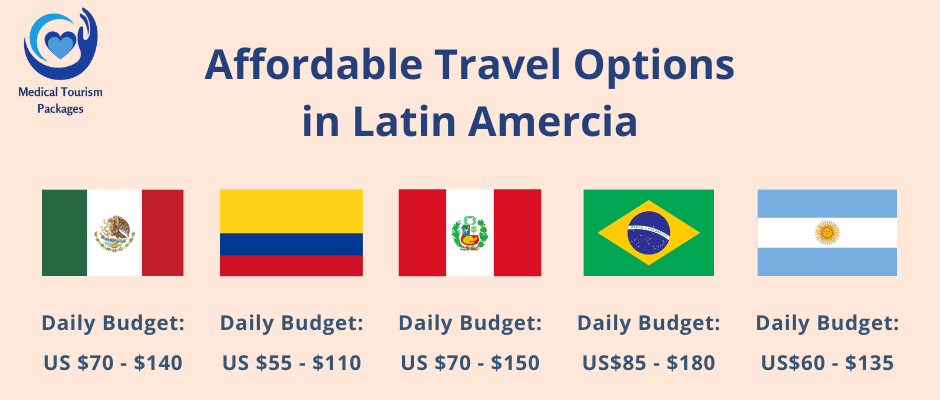
What Should American Medical Tourists Know About Safety in Latin America?
While Latin America offers excellent medical care, understanding safety protocols and emergency procedures is essential for protecting both your health and overall well-being during your medical journey.
How Can Americans Ensure Medical Safety During Their Procedure?
Following these essential safety protocols significantly reduces risks and ensures quality care during your medical tourism experience:
- Choose only accredited facilities with JCI certification or equivalent national accreditation demonstrating adherence to international standards
- Verify all doctor credentials before treatment by checking medical board registrations, specialty certifications, and training backgrounds
- Purchase Medical Tourism Insurance costing $200-$500 typically, covering complications and emergency evacuation services
- Work with established medical tourism facilitators who vet providers, coordinate logistics, and advocate for patients
- Follow CDC guidelines for international medical travel including recommended vaccinations and health precautions
What Are the Emergency Contact Numbers in Each Country?
| Country | Emergency Number | Ambulance | U.S. Embassy |
|---|---|---|---|
| Mexico | 911 | 911 | +52-55-5080-2000 |
| Costa Rica | 911 | 911 | +506-2519-2000 |
| Panama | 911 | 911 | +507-317-5000 |
| Colombia | 123 | 125 | +57-1-275-2000 |
How Do Americans Handle Follow-Up Care After Returning Home?
Successful medical tourism extends beyond the procedure itself, requiring careful coordination between your Latin American medical team and healthcare providers back home for optimal recovery outcomes.
What Aftercare Arrangements Should Americans Make?
Pre-arrange follow-up care with a U.S. physician before departure. Identify a local doctor willing to provide post-operative monitoring. Some American physicians hesitate to manage complications from foreign surgeries. Address this concern upfront by finding supportive providers. Telemedicine options connect patients with Latin American surgeons after return. Virtual check-ins monitor healing progress and address concerns. Mexico, Costa Rica, Panama, and Colombia all offer telemedicine follow-up services. Schedule these appointments before leaving the country. Many facilities include several follow-up consultations in the initial procedure cost. U.S. doctors may refuse to treat complications from foreign procedures due to liability concerns. This reality makes continuity planning critical. Obtain comprehensive documentation before departing Latin America. Include detailed operative notes, pathology reports, and post-operative instructions.
How Do Americans Transfer Medical Records Back Home?
Proper documentation transfer ensures continuity of care with your U.S. healthcare providers:
- Obtain all operative reports before departure, including detailed surgical notes and implant information if applicable
- Get written post-operative care instructions in English specifying medication schedules, activity restrictions, and warning signs
- Ensure records are translated to English by certified medical translators, though many facilities provide English documentation
- Request digital copies for easy sharing with multiple healthcare providers and insurance companies
- Keep original documentation for insurance claims, including itemized billing statements and proof of payment
Which Cities in Latin America Are Best for Medical Tourism?
Each Latin American country has developed specific cities as medical tourism hubs, offering distinct specializations, infrastructure, and patient support services tailored to international visitors.
Mexico’s medical tourism centers in Tijuana for border convenience and immediate access from California. Los Algodones hosts over 350 dentists in two square miles, creating the world’s highest concentration of dental practices. Cancun combines procedures with resort recovery along the Caribbean coast. Guadalajara offers complex surgeries in modern facilities with lower costs than border cities. For complete details on Mexican medical cities, see our Mexico Medical Tourism Guide.
Costa Rica concentrates services in San José, the capital hosting major international hospitals. Escazú features upscale private clinics in an affluent suburb. Santa Ana operates wellness-focused recovery centers surrounded by nature. Liberia serves beach resort areas on the Pacific coast. For comprehensive information on Costa Rican medical facilities, see our Costa Rica Medical Tourism Guide.
Panama focuses primarily on Panama City, where international hospitals cluster in accessible locations. The capital’s modern infrastructure supports medical tourism with direct flights and familiar amenities. Hospital Punta Pacifica and other JCI-accredited facilities operate in the city center. For detailed Panama City hospital information, see our Panama Medical Tourism Guide.
Colombia distributes medical tourism across multiple cities. Bogotá provides comprehensive medical services with the country’s largest hospitals. Medellín earned recognition as Colombia’s medical innovation center with cutting-edge facilities. Cali specializes in orthopedics and sports medicine. Cartagena combines procedures with Caribbean recovery settings and colonial charm. For specific Colombian city and facility details, see our Colombia Medical Tourism Guide.
Is Latin America Right for Your Medical Tourism Needs?
Yes, especially with Medical Tourism Packages guiding every step. Successful medical travel needs 3 to 6 months of planning. We verify surgeon licenses, board certifications, and hospital accreditations, coordinate teleconsults, schedule procedures, arrange flights and recovery lodging, and provide bilingual support. We also help you choose Medical Tourism Insurance for complication and emergency coverage. Skipping verification can erase savings. With us, credential checks are mandatory.
Latin America delivers world-class care at a fraction of U.S. costs. Mexico, Costa Rica, Panama, and Colombia each excel for different procedures and recovery goals. We match you to the right country, city, and surgeon, then present a clear, all-in plan that includes procedure fees, hospital stay, anesthesia, local transport, and aftercare.
Ready for a vetted shortlist and a precise budget?
Contact Medical Tourism Packages
Frequently Asked Questions
Why do American medical tourists choose Latin America for healthcare?
Lower costs, shorter wait times, and access to specialized care drive Americans to Latin America. The region blends traditional healing with modern, high-tech facilities, delivering comprehensive care that can equal or exceed U.S. standards at a fraction of the price.
How much can Americans save on medical procedures in Latin America?
Typical savings range from 40–80% compared to U.S. prices. For example, a $30,000 surgery in the U.S. might cost around $8,000 in Latin America—even after travel—thanks to lower operational costs, not lower quality.
Is healthcare quality in Latin America comparable to the United States?
Yes—top facilities hold international accreditations (e.g., JCI), use the same or newer equipment as U.S. hospitals, and employ surgeons trained in the U.S. and Europe. The main difference is cost structure, not clinical standards.
Which Latin American countries are best for American medical tourists?
Mexico, Costa Rica, Panama, and Colombia lead the region. Mexico excels in dental and border access; Costa Rica blends high-quality care with wellness environments; Panama offers U.S.-aligned protocols and uses the dollar; Colombia is renowned for cosmetic surgery and experienced specialists.
How geographically convenient is Latin America for U.S. patients?
Very convenient: Mexico’s border cities are minutes from the U.S.; Costa Rica and Panama have frequent 3–5 hour flights from major hubs; Colombia connects directly to cities like Miami, Houston, and New York, reducing travel time and costs.
What procedures are most common—and what are typical price ranges?
Popular procedures include cosmetic surgery (e.g., breast augmentation ~$3,000–$6,500 in Latin America vs. $6,000–$12,000+ in the U.S.), dental implants ($750–$1,500 vs. $3,000–$4,500), bariatrics (gastric sleeve/bypass), and orthopedics (knee/hip replacements ~$10,000–$20,000 vs. $35,000–$60,000 in the U.S.). Exact pricing varies by country and facility.
How do I verify hospital and doctor credentials before booking?
Look for JCI or equivalent accreditation and national approvals (e.g., COFEPRIS in Mexico). Verify physicians via country medical boards (CONAMED/Mexico, Colegio de Médicos/Costa Rica, Consejo Técnico de Salud/Panama, Ministerio de Salud/Colombia). Confirm board certification, active license, U.S./EU training, and hospital privileges.
What documents and visas do U.S. patients need?
Bring a valid passport and medical records. Visa-free stays are common: Mexico (up to 180 days), Costa Rica (up to 90 days), Panama (up to 180 days; passport usually valid 3+ months beyond arrival), and Colombia (up to 90 days; passport valid 6+ months). Always confirm current rules before travel.
How long should I plan to stay for recovery after common procedures?
Typical timelines: Dental (3–7 days initial, travel-clear 1–3 days), Cosmetic (7–14 days initial, travel-clear 7–10 days), Bariatric (5–7 days initial, travel-clear 10–14 days), Orthopedic (7–10 days initial, travel-clear 14–21 days). Full recovery ranges from 1–2 weeks (dental) to 3–6 months (orthopedic).
How should I handle aftercare and medical records when I return to the U.S.?
Pre-arrange a U.S. physician for follow-up before you travel. Obtain operative notes, imaging, implant details, prescriptions, and post-op instructions (preferably in English and digital form). Many facilities include telemedicine check-ins so your surgeon can monitor healing after you’re home.
What safety steps and emergency resources should I know about?
Choose accredited facilities, verify surgeon credentials, and consider medical tourism insurance ($200–$500 typical). Follow CDC travel guidance. Local emergencies: Mexico/Costa Rica/Panama dial 911 (U.S. embassies available), Colombia dial 123 (ambulance 125). Work with reputable facilitators for added oversight.

